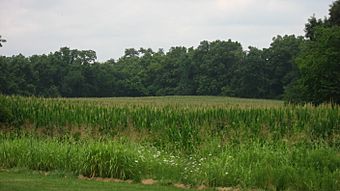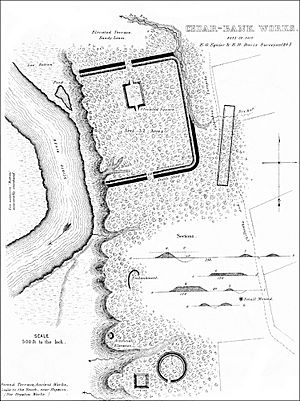Cedar-Bank Works facts for kids
Quick facts for kids |
|
|
Cedar-Bank Works
|
|
 |
|
| Lua error in Module:Location_map at line 420: attempt to index field 'wikibase' (a nil value). | |
| Nearest city | Chillicothe, Ohio |
|---|---|
| Area | 32 acres (13 ha) |
| NRHP reference No. | 74001614 |
| Added to NRHP | February 15, 1974 |
Cedar-Bank Works is a fascinating collection of ancient earthworks built by the Adena culture. These amazing structures are located in Ross County, Ohio, about five miles north of Chillicothe, Ohio. They are a special part of history in the United States.
Contents
Who Built Cedar-Bank Works?
The Cedar-Bank Works were created by the Adena culture. This ancient group of people lived in the Ohio Valley a very long time ago. Experts believe these earthworks were built even before the famous sites at Hopewell Culture National Historical Park. We don't know the exact date when Cedar-Bank Works was built.
Exploring the Cedar-Bank Works
Early Surveys by Squier and Davis (1845)
In 1845, two explorers named Ephraim George Squier and Edwin Hamilton Davis carefully studied the Cedar-Bank Works. They wrote about their findings in a book called Ancient Monuments of the Mississippi Valley in 1848.
They described the main part of the site as having three sides made of walls and ditches. The fourth side was naturally protected by a steep hill, about 70 feet high. This hill was so steep you could only climb it in one spot.

Squier and Davis measured the walls. They were about six feet tall and 40 feet wide at the bottom. The ditches next to the walls were five feet deep and 40 feet wide. The eastern wall was the longest, stretching 1,400 feet. The northern and southern walls were each 1,050 feet long. They formed perfect right angles.
There were two entrances to the main area, one on the north side and one on the south. Inside the northern entrance, they found a raised square area. It was four feet tall and measured 250 feet by 150 feet. They thought it was similar to the pyramids found at the Marietta Earthworks.
Squier and Davis also found two parallel walls about 300 feet away from the main site. These walls were 870 feet long and 70 feet apart. They noticed that a road, the Chillicothe Turnpike, had damaged some parts of these walls.
Other Discoveries at the Site
About a third of a mile south of the main earthworks, Squier and Davis found a flat-topped pyramid and a small circle. The pyramid was 120 feet square at its base and nine feet tall. It was perfectly lined up with the main directions (north, south, east, west). They dug into the pyramid but didn't find any remains.
The circle was 250 feet across with a 30-foot wide entrance on its south side. It had a ditch inside and a raised bank. Modern archaeologists would call this a "C-form" earthwork because of its open shape. Squier and Davis thought the builders chose this spot for the pyramid and circle because it had a "fine view" of the river.
What Were They Used For?
After their survey, Squier and Davis weren't sure what the earthworks were for. They thought the main walls looked like fortifications, meaning they might have been used for defense. However, the large entrances made them wonder if it was truly a military site. They suggested the area might have been used for "celebration of certain games" or important religious ceremonies.
Later Observations (1902)
In 1902, the Ohio Historical Society also looked at the Cedar-Bank Works. A researcher named Gerard Fowke noted that the river was probably much closer to the earthworks when they were first built. He also saw that farming had damaged many of the walls since Squier and Davis's visit.
Fowke also disagreed with Squier and Davis about the pyramid. He believed the ground where the pyramid was built was naturally flat, not smoothed out by the builders.

